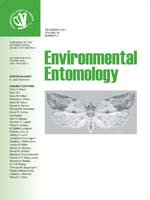In longhorn beetles and many other internally feeding insects, oviposition choice by females is critical to the survival of their offspring because their larvae are incapable of moving between hosts. Here we report on the complex host selection and colonization strategies of a longhorn beetle, Glenea cantor (F.) (Coleoptera: Cerambycidae), which is an important pest of kapok trees [Bombax ceiba L. = Gossampinus malabaricus (DC.) Merr.] in southern Asia. It attacks weakened trees, eventually killing them. The typical oviposition behavioral sequence in the laboratory includes the following: oviposition site search and recognition using antennae and palpi, oviposition slit preparation with mandibles, turning body direction 180°, egg deposition with the ovipositor, and oviposition wound covering with a jelly-like material from the ovipositor. Bark moisture content significantly increases from the upper to lower sections in kapok trees. In accordance with this variation female adults select the upper section of trees first for oviposition. As infestation continues and the host becomes more weakened, ovipositing females move further down the tree for oviposition. Consequently, the larvae kill the hosts from the top down. We show that the jelly-like material or eggs or both have an olfactory role in attracting females to oviposit nearby. Our findings are important in terms of increasing our understanding of host selection and colonization mechanisms of internally feeding insects, particularly cerambycids, and the development of environmentally friendly pest management measures.
How to translate text using browser tools
1 December 2011
Host Selection and Colonization Strategies with Evidence for a Female-Produced Oviposition Attractant in a Longhorn Beetle
Wen Lu,
Qiao Wang,
Ming Yi Tian,
Jin Xu,
Ai Zhi Qin,
Lan He,
Bao Jia,
Jing Jing Cai
ACCESS THE FULL ARTICLE
It is not available for individual sale.
This article is only available to subscribers.
It is not available for individual sale.
It is not available for individual sale.

Environmental Entomology
Vol. 40 • No. 6
December 2011
Vol. 40 • No. 6
December 2011
bark moisture content
colonization
Glenea cantor
host selection
oviposition attractant




